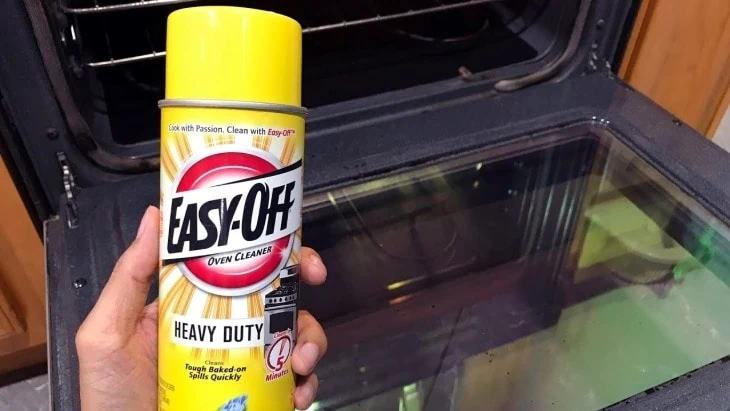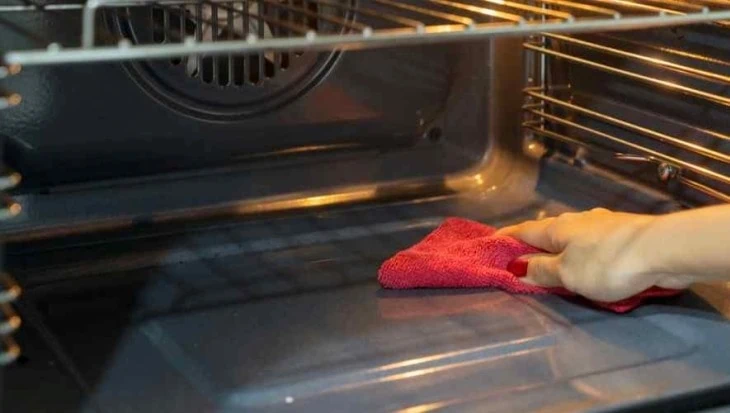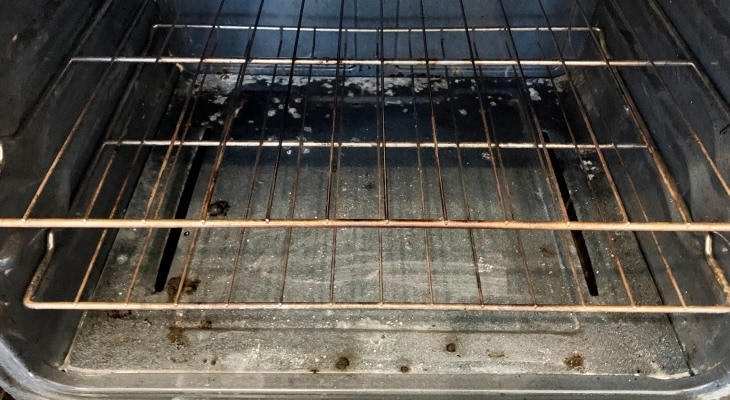Cleaning your oven is an important part of kitchen maintenance. Whether you are a homeowner or renter, or maybe you are a professional housekeeper, this is a required skill.
Ovens are the centerpiece in the “heart of the home” if you will.
With today’s technology, many ovens come with a self-clean mode, but even those can require the use of an oven cleaner such as Easy Off.
This can, however, come with some unexpected hiccups along the way. One of which is starting your oven before the cleaner has been completely wiped away.
Table of Contents
Started Oven with Oven Cleaner Inside? Here’s What to Do!

Starting the oven while it’s full of chemicals can be frightening. Even when it’s a household brand like Easy Off. However, these tips will get you cooking safely again in no time.
First, Turn off the Oven
Once you have realized the oven is on, it’s important to turn it off immediately. The heat from the oven heats up the chemicals and starts to release them into the air. The longer it stays on, the more fumes will be released.
Increase Air Flow
Now that the oven is off, make sure to turn on the exhaust fan and open any windows you can. You should open the oven door at this time to let the oven box also air out.
Allow the room to air out and the oven to cool for at least thirty minutes. Now would be a good time to remove and discard any food that may have been in the oven.
Check Your Oven Cleaner’s Ingredients and Warnings
Whether it’s the good ol’ Easy Off or some other oven cleaner, you need to ensure it does not contain bleach or any ingredient that reacts to vinegar. Once you have verified that, proceed to the next step.
Gather Cleaning and Safety Supplies
You will need white vinegar, water and two dish rags or sponges to remove the cleaner from the oven. If available, you can also use a bucket and a spray bottle.
Fill the bucket or sink with water to rinse rags in, changing the water as needed. Fill the spray bottle with vinegar. Since oven cleaners can cause chemical burns, it is also a good idea to use latex gloves.
Now It’s Time to Clean It Out!
Now that you have safely aired the room out, let the oven cool, and gathered supplies, it is time to clean. The first thing you will want to do is put gloves on to protect your hands.
Next, wipe away any visible oven cleaner with a damp rag.
Now, spray the inside of the oven, or saturate a new rag with vinegar and wipe down, alternately using the white vinegar and water to wipe out the oven.
Repeat this cycle at least 3 times or until you no longer see or smell the oven cleaner.
Final Step – Dry Out the Oven

Using a dry cloth, wipe out the oven one final time. Once that is done, turn your oven on to 300 and let it run for 30 minutes.
This will ensure that any remaining vapors from the Easy Off, or similar cleaner, will be removed from the oven, allowing you to safely cook in it once more.
Can I Use Other Vinegar Types?
The short answer to this question is yes!
How to Use Cleaning Vinegar Instead?
Cleaning vinegar is very similar to regular white vinegar. The difference is cleaning vinegar is more acidic. To dilute, mix one part vinegar with one part water.
Do You Only Have Apple Cider Vinegar?
Apple cider vinegar will work, also! Again you will want to dilute with at least one part water. This can have a stronger smell than other vinegars so if a one-to-one ratio still smells too strong for you, try two parts water to one part vinegar.
Can I Use Something Other than Vinegar?

Vinegar works the best to neutralize most oven cleaners. Vinegar is an acid whereas most oven cleaners are alkaline.
The vinegar works by pulling the pH level of the oven cleaner down to a more neutral or tolerable level. This will reduce the fumes and odor as well. However, there are a few options!
Use Regular Hot Water
That’s right. You can use straight hot water. This will take longer to neutralize and remove the odor, but it does work.
Just wet your rag, wipe out the oven, rinse the rag, and repeat. Continue this process until the oven is free of cleaner residue and odor.
Lemon Juice Works Too!
Lemon juice is another great alternative to vinegar. It will work as a neutralizer like vinegar, with a much softer scent.
To use, juice the lemon into one cup of water and pour it into a spray bottle. Spray the oven with solution wipe and repeat. Be sure to rinse the rag with clean water occasionally as well. Repeat until the oven is clean.
Other Commonly Asked Questions
Can Oven Cleaner Ruin Your Oven If Left Inside?
Yes, unfortunately, it is possible to ruin your oven if you leave the oven cleaner inside. Even Easy Off can eat away the enamel inside self-cleaning ovens.
To avoid this, you should always follow the instructions listed in the oven manual and the oven cleaner’s label.
What If You’ve Used an Oven Cleaner on a Self Cleaning Oven?
Check your product to see if it is safe for self-cleaning ovens. Some products, including a fume-free version of Easy Off, are considered safe. If your cleaner is one that is safe for self-cleaning ovens, follow the instructions provided with the product.
If you have one not recommended for your appliance, remove it using the steps above as soon as possible. Do not turn on the self-clean function to assist in this, as that can cause more damage.
How Long After Using Easy Off Can You Use Your Oven?
Once you have removed the cleaner, your oven should be safe to use immediately. Make sure you can visually inspect the oven for any leftover residue.
Next, check for any chemical odors, and finally, do preheat the oven to 300 degrees to check for any smoke or fumes. If there are no signs of missed cleaner, you are safe to cook now!
Prepare for Next Time
Life is far too often a frenzy of multitasking. I like to set myself reminders when doing things that require me to leave things unfinished, like using an oven cleaner.
If possible, you can do this on your phone or even the oven itself if you’ll be around to hear it. Even if you do forget again, though, now you have the added skill of knowing how to fix it. Happy and safe cooking!

